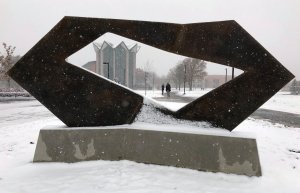Cover Art Commentary: Gregg Hertzlieb on Neil Goodman

Neil Goodman (b. 1953)
Night and Day, 2016-2019
Cast and welded bronze
Gift of Robert L. and Violet V. Berge
Brauer Museum of Art, 2019.19
The Brauer Museum of Art and Valparaiso University are delighted to welcome artist Neil Goodman’s beautiful bronze sculpture, Night and Day (2016-2019) to the university’s campus. This commissioned sculpture was funded by a generous gift from Robert L. and Violet V. Berge.
Night and Day is a sculpture that writhes as a complex form, nearly living by attracting viewers with its surface and belying through its hand-wrought nature the heaviness and fabricated identity of the materials. The sculpture is still and massive, and yet the complex relationships of planes and angles put the sculpture in motion, with side views confounding the stability of the frame at particular angles. Goodman’s creation is simultaneously and paradoxically a weighty object of welded and grinded bronze, a frame that sculpturally activates the spaces all around it, and an object in constant motion as viewers encounter it motionlessly shifting and defying balance. The artist has remarkably created something that causes viewers to marvel at its scale and visual and physical weight while it urges a closer relationship so that it may impress with its golden color tones, its surface details, and its twists in space that viewers feel in their bodies as they ride the lines of the sculpture with their eyes and follow the leans and bends.
Night and Day features as a compositional element a void in the center that makes the sculpture something of an abstracted and expressive frame. When he worked on the initial forms leading up to this piece, he likened the voids to lenses that created vignettes of the landscape, which define and encapsulate surrounding views. Inspired by the Hudson River School paintings that constitute an area of focus in the Brauer’s collection, Goodman continued to work with and expand upon that idea with his sculpture, so that now lovely views of the Chapel of the Resurrection, Center for the Arts, and other campus highlights are framed by the massive bronze.
Goodman’s sculpture also calls attention to the language of art, the language of sculpture. The surface, formed from labor-intensive casting and finishing, reflects a fascinating textured history, with the bronze displaying its scars, its history, its evolution brought about by the artist’s careful attention. The softly rounded edges of the form, coupled with the visual warmth of the surface, give the piece an organic vibe—despite the fact that it is made of bronze, it reminds viewers of bones and shells that grow as opposed to forms that are mechanically fabricated.
A sculptor with a long and distinguished career, Neil Goodman (b. 1953) spent time at Valpo experiencing the space and topography of the landscape; as well as in the Brauer Museum, getting acquainted with the collection and its history. Goodman used those experiences and insights to initially produce a number of small scale bronze studies or maquettes that were on display in the Brauer Museum in 2016. The exhibition of these maquettes was very popular with students and community visitors, leading the artist to refine his vision and to arrive at the final study for the commissioning of the finished sculpture.
Night and Day joins Richard Hunt’s large outdoor 2013 stainless steel sculpture Valpo Variations on campus; separated by a few hundred yards, the sculptures engage in silent dialogue. The two pieces converse across space but also converse across time. Hunt’s organic and surreal Modernism contrasts with Goodman’s more grounded creation, but the qualities of the Hunt tease out references and surface treatments in Night and Day that point to Hunt as an enduring influence on Goodman. The Brauer Museum is fortunate to have small scale bronze maquettes for both Valpo Variations and Night and Day so viewers can explore the concept of model vs. monument. The two large sculptures considered together and with their preparatory maquettes, create a dialogue between generational influences, and although uniquely different artists, both sculptors are linked by the seductive nature of their materials, and the spatial effects that occur when the works are experienced on small and large scales.
Gregg Hertzlieb is Curator and Director of the Brauer Museum of Art at Valparaiso University and a Contributing Editor to Valparaiso Poetry Review. Hertzlieb is the editor of the books The Calumet Region: An American Place (Photographs by Gary Cialdella), published in 2009, and Domestic Vision: Twenty-Five Years of the Art of Joel Sheesley (2008), as well as a contributor to The Indiana Dunes Revealed: The Art of Frank V. Dudley (2006). He has been awarded the Edward L. Ryerson Traveling Fellowship by the School of the Art Institute in Chicago and a Conant Writing Award for Poetry from Millikin University. His artwork has been exhibited widely, including at the Aron Packer Gallery, August House Studio, the Central School of Art and Design in London, Columbia College, Elgin Community College, the Goodman Theater, Struve Gallery, and the Ellen Firme Gallery.